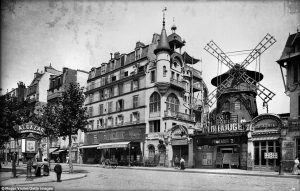Moulin Rouge
Moulin Rouge means “red mill.” A visitor to the Montmartre district of Paris in 1889 would have seen a four-story red windmill incongruously standing between two commercial buildings in an area that was a magnet for the “creative class” of the day. The spirited “red mill” cabaret synonymous with “can-can” dancers and painter Toulouse-Lautrec is a cultural galaxy away from the iconic red mills of Lowell. But a mill is a mill is a mill, to borrow from Gertrude Stein—or is it?
Web photo courtesy of Getty Images
What a simple word, almost too short to notice and soft when pronounced: mill. Yet this is the basic fact of the city named Lowell. Mill is an old word, Old English mylen and before that Latin millesimum. From the same root come the words mild, melt, mold, meld, maul, milt, mull, malt, mulch. It is a verb and a noun, the action word giving rise to the thing we call “mill,” a combination of process and place having to do with grinding—and then making, manufacturing. The meaning circles back to the red mill in Paris, not an actual windmill but pretending to be for the village aura of Montmartre. The original windmills had wind-spun, tower-mounted crossed blades (or sails) whose rotation turned a grain-grinding wheel inside to make “meal” (sounds like “mill”) or coarse baking flour. Any operation driven by a turning wheel, whether driven by wind or water, took on the mill name. Sawmills cut huge logs into boards. Later, mill was applied to a place of production in general, such as a steel mill. The Lowell mills carried the wheel-driven-production meaning at first and later stood for the broader meaning: place of manufacture or factory.
The Lowell mills stretch along the edge of the Merrimack for about a mile and disperse slightly inland on a spider web of canals. If a rider was approaching Monument Valley National Monument in Utah and saw the red sandstone buttes, some of which are blocky, resembling buildings, and others attenuated like spires and towers, the rider would not automatically think of the nineteenth-century red brick mills of Lowell. But if later two panorama views of the scenes were compared, the similarity would be striking: the saturated magnesium-oxide color, boxy shapes punctuated by tapered uprights, and fortress-like objects lined up across the landscape.
Web photo courtesy of myutahparks.com


Interesting post… there was in the 1940’s a night club in Lowell in the vicinity of the old Lawrence Company mills called the Moulin Rougue that took it’s inspiration from the famous one in Paris. According to the Sampas Scoopies columns in old Lowell Sun editions, it was a very popular spot featuring stand up comedy and other acts.